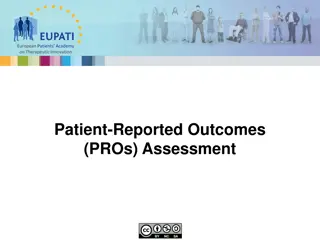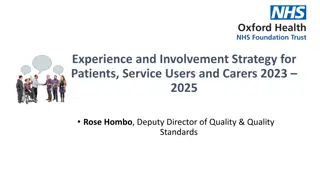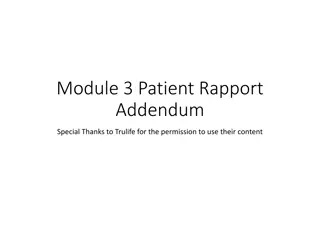Dealing With Difficult Patients: Strategies for Effective Patient Management
Learn valuable insights from "Dealing With The Difficult Patient" by Victor B. Klausner, DO. The content emphasizes the importance of handling challenging patient interactions with empathy, professionalism, and ethical conduct. It provides practical tips on communication, patient empowerment, managing emotions, setting boundaries, and maintaining a positive patient-provider relationship.
Download Presentation

Please find below an Image/Link to download the presentation.
The content on the website is provided AS IS for your information and personal use only. It may not be sold, licensed, or shared on other websites without obtaining consent from the author.If you encounter any issues during the download, it is possible that the publisher has removed the file from their server.
You are allowed to download the files provided on this website for personal or commercial use, subject to the condition that they are used lawfully. All files are the property of their respective owners.
The content on the website is provided AS IS for your information and personal use only. It may not be sold, licensed, or shared on other websites without obtaining consent from the author.
E N D
Presentation Transcript
Dealing With The Difficult Patient Presented by Victor B. Klausner, DO The Center for Occupational Health and Wellness
The True Art of Healing - Method Allow patients to express their feelings Encourage patients to stay focused with a positive attitude, and Never discount the healing power of the human mind and soul Encourage a realistic level of activity to enhance healing and preserve self-esteem/independence Empower patients with a sense of control Set realistic goals to recovery
The True Art of Healing - Method Identify patients at high risk for psychiatric disease early and treat appropriately/aggressively Address psychosocial issues which may be inhibiting the healing process Remove the possibility of personal gain Address dysfunctional behavior with counseling and lifestyle modification. Sometimes laughter is the best medicine
Dealing With The Difficult Patient The Golden Rules Do the right thing and remain ethical at all times Be as courteous, calm, and professional as possible Deliver the best possible treatment you can give Give the patient decision-making capacity Never be intimidated by insistent patients Never be condescending to patients Meticulously document patient encounter Know your patient well with a thorough history
Dealing With The Difficult Patient The Golden Rules Never lose your temper Do not feel obligated/Never put yourself in danger Do no let your ego be adversely affected by a patient s anger, non-compliance, or manipulation Understand your own limitations and personality, and manage your emotions carefully Avoid emotions that cloud your judgment and over- personalize your interaction Be Empathetic, in spite of it all
Dealing With The Difficult Patient The Golden Rules Allow the patient autonomy in regards to medical options, but set limitations with consequences if they refuse recommended treatment options Apologize to the patient if appropriate If the patient is angry or insulted about a situation that didn t involve you, apologize anyway Never bad mouth a colleague Acknowledge that you are a partner in their care but that you are also a trained professional - Boundaries Have compassion and listen attentively to your patient s frustration Focus on the big picture Helping The Patient
Mistakes When Dealing With Difficult Patient Don t Interrupt patients. Instead, give them time to express themselves. Don t Get into a contest of right vs. wrong Don t Mirror their behavior (i.e. passive aggressive ) Don t Ignore a patient s concerns or cut them off. Don t Make dismissive comments. Don t Allow patients to trigger anger/neg. emotions Avoid Defensive response and Defensive posture
10 Tips For Managing Difficult Patients Listen and affirm ( This is what I hear you saying . correct? ) Communicate and explain (Pt. may not understand policies) Take a deep breath! (Think before you reply) Exercise self-control (Control your emotions ) Be constructive (Focus on what you can do to help ) Share the problem (Discuss difficult patients with colleagues) Let go of your ego (Ask yourself what s the best outcome?) Practice makes perfect (Role-play difficult scenarios ) Display your policies (Co-pays, refills, pain meds, etc ) As a last resort, you have option to break off the relationship.
Dealing With The Violent Patient 1. Respect personal space while maintaining a safe position. If a situation begins to escalate, make sure that both you and the patient have adequate personal space. No one should feel trapped or cornered. 2. Do not provoke. Keep a calm demeanor, and make sure your body language reflects non-confrontation. Avoid judgmental/confrontational body language (e.g. staring, clenching fists, and crossing your arms). 3. Establish verbal contact. Only one person should talk with the patient in an attempt to de-escalate the situation. Speak calmly and politely to the patient, and assure of goal to resolve issue and keep everyone safe. 4. Be concise; keep the message clear and simple. Use clear, short and simple vocabulary to help patient comprehend messages without further agitation. Give patient time to process information and respond. 5. Identify wants and feelings. Try to determine what the patient expects, wants, feels, and identify alternative options that might help them regain control of behavior. Respond with empathy and compassion in order to establish trust and rapport.
Dealing With The Violent Patient 6. Listen closely to what the person is saying. Actively listen to the complaints or concerns and give verbal indications that you hear their message. Helpful to repeat key information back to the patient. 7. Agree or agree to disagree. Try to find common ground with the patient and identify opportunities for agreement, whether based on facts or principles. If an agreement can t be reached, agree to disagree, but acknowledge the patient s feelings. 8. Lay down the law and set clear limits in non-threatening manner. Negative behaviors have consequences, and you should calmly, but clearly inform the patient about unacceptable behaviors and potential consequences (e.g., alerting security or law enforcement). 9. Offer choices and optimism. Consider realistic alternatives to violence that you can offer the patient. Doing so can help empower the patient and potentially de-escalate aggression. 10.Debrief the patient and staff. After de-escalation, work with patient to discuss situation, understand their perspective, and devise strategies for controlling aggressive and hostile behavior in the future.
When Confronted With Difficult Patient Take HEART Hear Them Out Empathize Acknowledge situation and validate patient. Apologize if appropriate. Respond with thoughtful/controlled emotions. Take responsibility for your sphere of influence Thank patient for understanding complex issues.
Coping With Difficult Patients Avoid judgmental or prejudicial behavior. Be patient/tolerant of others who may approach healing treatments different than you. Get thorough history and establish rapport. Use direct communication and be honest. Be selective about personal disclosure. Use Humor to disarm a patient s defensive posture or manipulative behavior.
Were All In This Together Victor Klausner, D.O. Cell: 702-683-0897 E-mail: vklausner@cohmedical.com























